We consider the pearl oyster mushroom to be one of the most popular and iconic of all the oyster mushroom strains.
It’s the first mushroom that really allowed for simple home cultivation and small-scale mushroom farming. So we think it’s worth devoting a whole post to cover it in depth.
In this article, you’ll learn what a pearl oyster mushroom and black pearl oyster mushroom are.
We’ll also explain the health benefits of these mushrooms, where they grow, how to grow them and more.

What Are Pearl Oyster Mushrooms?
The pearl oyster is one available strain of the oyster mushroom species (Pleurotus ostreatus).
It’s grown commercially around the world for food production. You can find these mushrooms in many grocery stores and supermarkets.
Pearl oysters get their name from the way that they look. Their color ranges from cream-colored to gray in appearance, reminiscent of a pearl.
Like other oyster mushrooms, their overall shape has a somewhat seashell-like appearance. This might also contribute to the name.
The pearl oyster mushroom is a cool-weather variety, similar to blue oysters.
Like all oyster mushrooms, they can be used in a wide variety of different culinary dishes.
They’ve also got some medicinal properties, which we’ll discuss a bit later.
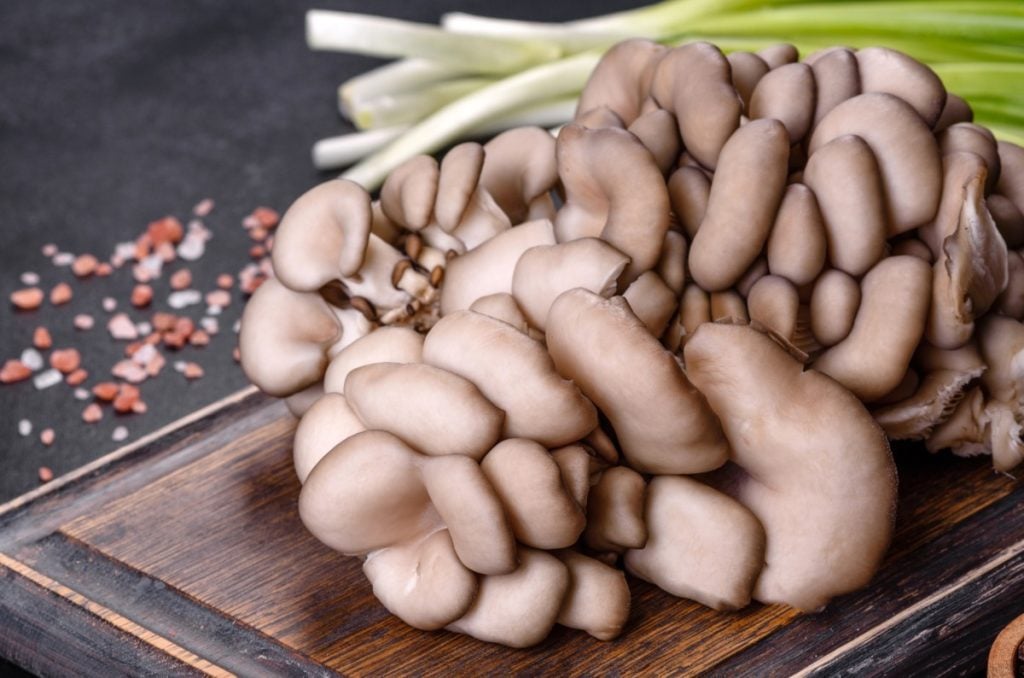
What Are Black Pearl Oyster Mushrooms?
The black pearl oyster mushroom is a hybrid variety that originated from Japan.
The exact genetics are not known, but it is believed to be a hybrid cross between European and Asian varieties of the Pleurotus ostreatus mushroom.
When these mushrooms first start to grow, they look much like a king oyster (pleurotus eryngii) mushroom. But as they mature, they flatten out and look closer to a standard oyster mushroom.
This hybrid grows well indoors and is less difficult to grow than king oyster mushrooms.
It will quickly colonize the same substrates as other oyster mushrooms. For example, substrates like hardwood sawdust or straw.
Like the pearl oyster, the black oyster prefers cooler temperatures when fruiting. Between 12 – 16 C (55 – 61 F) is ideal.
When cooked, the black pearl mushroom has a more firm and dense texture than most mushrooms.
The stem is a similar texture to the cap, making the whole mushroom edible and easily transformed into mushroom scallops or steaks.
This feature makes it more similar to the king oyster for culinary purposes.
The flavor of the black pearl oyster mushroom is usually described as sweet and meaty. You may also notice a peppery aftertaste.
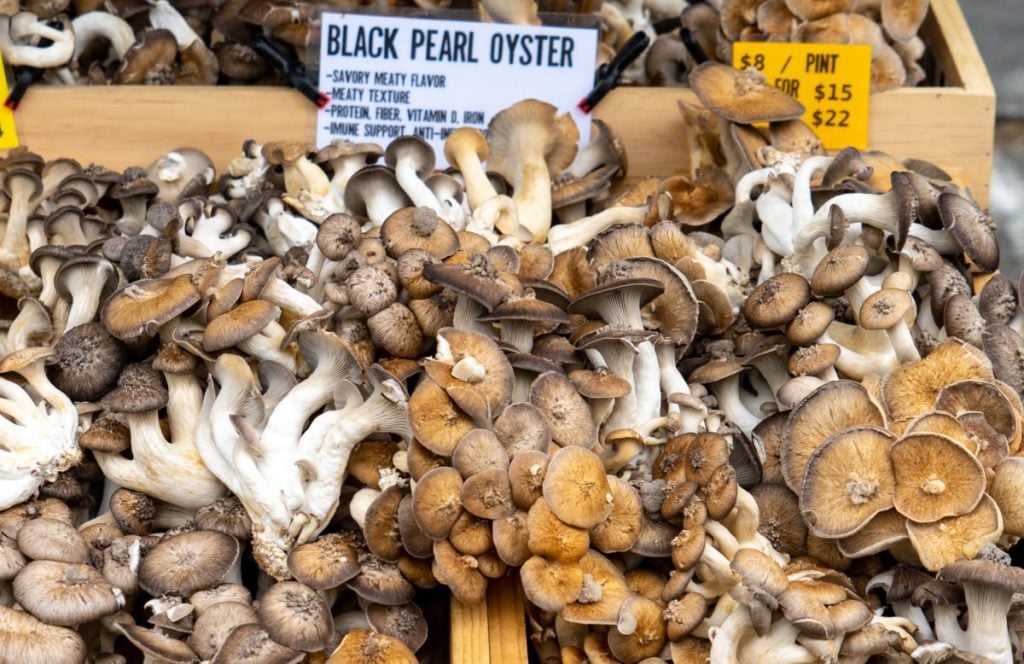
Where and When Do Pearl Oyster Mushrooms Grow?
Pearl oyster mushrooms are a cultivated strain of Pleurotus ostreatus mushrooms.
Genetically, pearl oysters are the same species as wild oyster mushrooms.
However, they look a little different in the wild compared to when farmed.
You can think of it in the same way that domesticated pigs and wild boars are technically the same species.
In the same way, oyster mushrooms have different appearances depending on whether they’re grown indoors or in the wild.
Pearl oyster mushrooms are commonly cultivated indoors. Since they’re so easy to grow and can be grown year-round, there isn’t a huge market for wild foraged ones.
If you want to go looking for wild oyster mushrooms like pearl oysters, it’s best to go looking in the autumn.
Pearl oysters prefer cooler temperatures. So the wild oysters that you find at this time of year should be more similar to pearl oysters than other varieties.
Oyster mushrooms are quite widespread. They can be found in forests of many temperate and subtropical climates around the world.
You’ll have the best chance of finding wild oysters after strong weather changes. For example, after a frost, or after several days in a row of rainy weather.
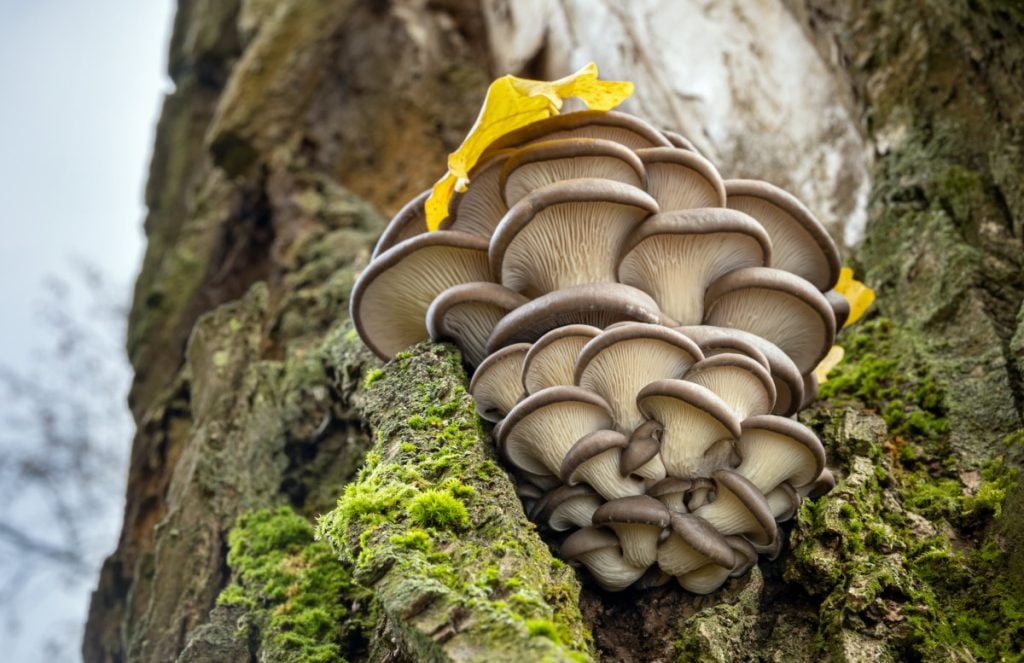
What’s the Best Tasting Oyster Mushroom?
When it comes to anything food-related, it’s a matter of personal preference. So the best tasting oyster mushroom is up for debate.
In our opinion, we would probably say either the pearl oyster or golden oyster mushroom.
Pearl oysters have a nutty flavor with hints of sweetness and earthy undertones. They’re slightly soft, but they also have a chewy texture.
They’re a thicker and more meaty mushroom when compared to summer mushrooms.
So pearl oysters will hold up better in things like stir-fries. Or in any recipes where you’re cooking for longer or at higher temperatures.
You can’t really go wrong with any oyster mushroom though. Any oyster mushroom will help add a savory kick to your dish.
Well, there are a couple of exceptions. Most oyster mushrooms have a fairly neutral taste.
The pink oyster is one exception that has an almost seafood-like smell and taste. So it’s best reserved for when cooking seafood dishes.
The king oyster is also quite different from other oyster mushrooms in size and texture. It’s a lot more like eating a wild boletus mushroom.
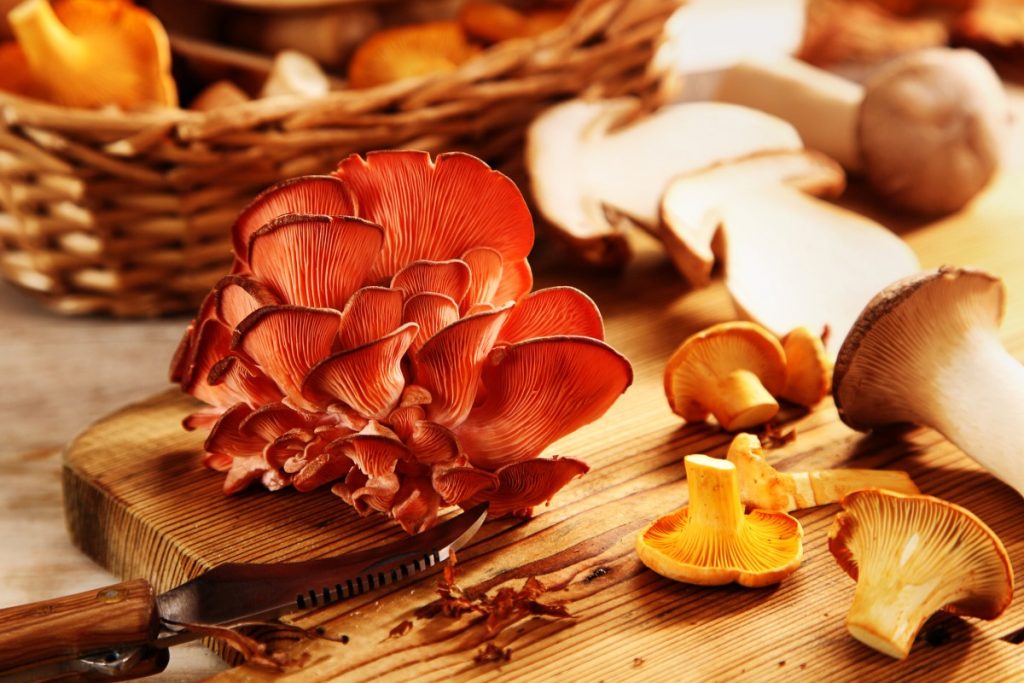
How Can You Tell a Pearl Oyster From Other Varieties of Oyster Mushrooms?
The main way for an average person to separate a pearl oyster from other varieties is by its color.
If the oyster mushroom that you’re looking at is gray or cream colored, then it’s most likely a pearl oyster. If it’s golden, pink or blue then it’s most likely another variety.
If you’re buying directly from a mushroom grower, they will be able to tell you what variety of oyster mushroom they’re growing.
In grocery stores or supermarkets, it’s common to just see a label of “oyster mushroom” without listing a specific strain.
However, pearl oysters do tend to be the most commonly available oyster mushroom in shops.
So if you’re buying oyster mushrooms in the produce section, you’re most likely getting pearl oysters.
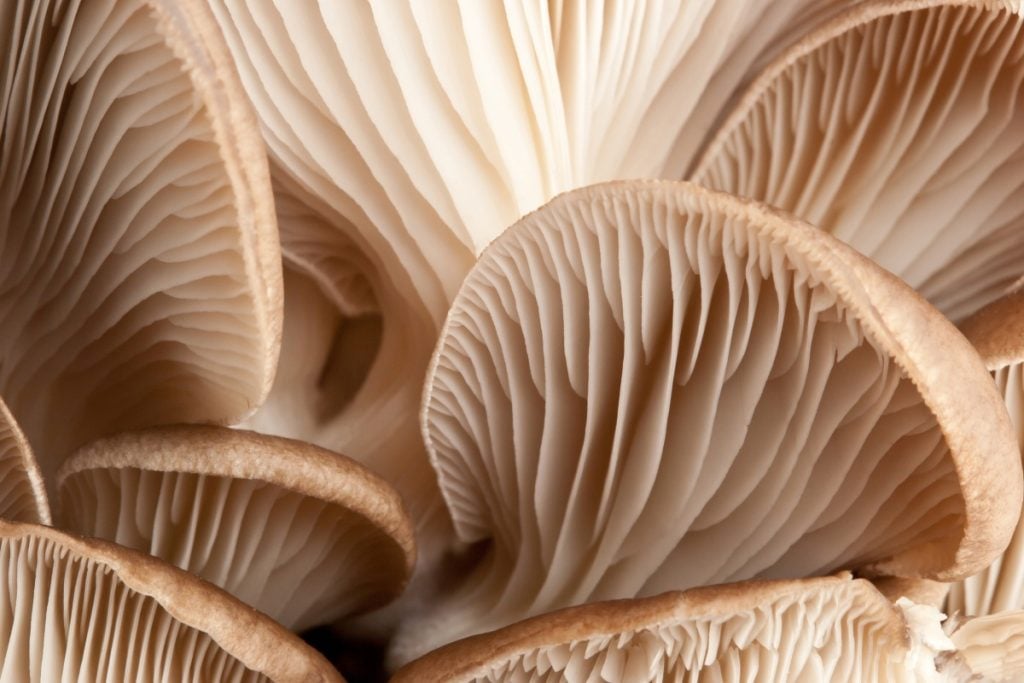
Is the Oyster Mushroom Toxic?
Oyster mushrooms are completely edible and not toxic, assuming that you can correctly identify them.
However, we don’t recommend eating any wild mushrooms unless you’re sure that you can positively identify them.
If you want to be sure that you’re eating edible oyster mushrooms, buy them from reputable sellers. Buy from those who are providing commercially-grown oyster mushrooms instead of wild-harvested ones.
As with any food, it’s always possible that you could have a food allergy to oyster mushrooms.
People who have experienced a reaction to eating other types of mushrooms in the past should use caution. Only try a small amount of oyster mushrooms at first, if at all.
If you become ill after eating oyster mushrooms, contact your regional Poison Control Center for medical advice.
Save some of the leftover mushrooms if possible, to help identify and confirm what you’ve eaten.
People with mushroom allergies can experience swelling, trouble breathing or other medical issues. If any of these occur, call your regional emergency number for immediate help:
- North America – 911
- United Kingdom – 999
- Any EU country – 112
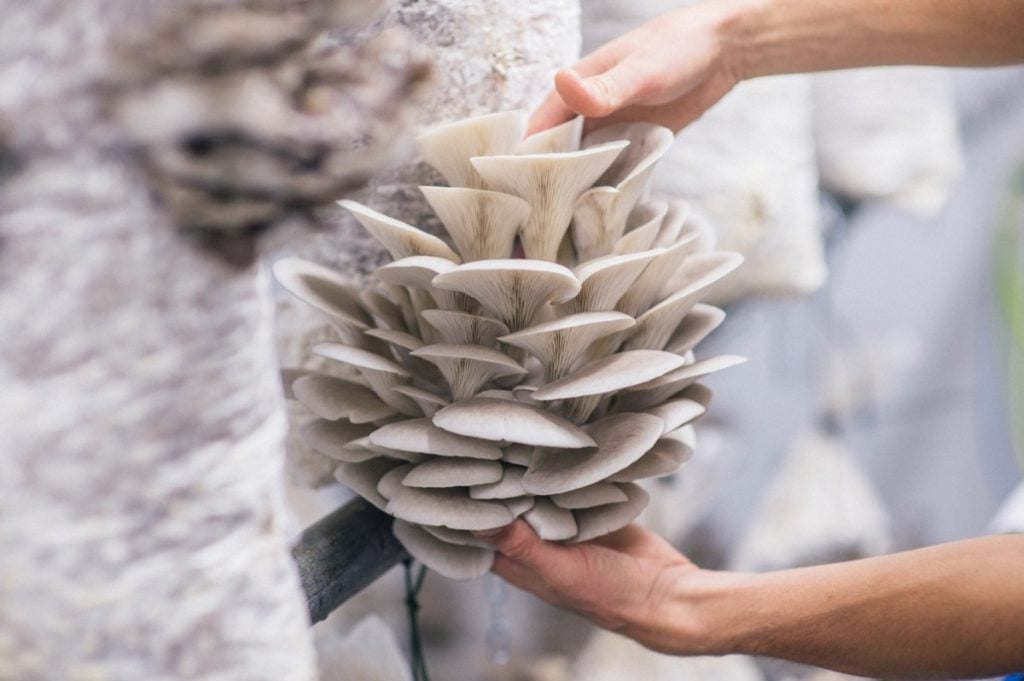
Risks of Growing Oyster Mushrooms
If you are growing oyster mushrooms yourself, one thing to be careful of is the spores of the mushroom.
Commercial growers have developed allergies to oyster mushroom spores over time.
There are cases of mushroom farmers having anaphylactic reactions to oyster mushroom spores.
You can minimize the risk by harvesting oyster mushrooms before they fully open and begin to drop spores.
We also recommend wearing a respirator when harvesting oyster mushrooms. This will help prevent you from inhaling any spores.
Pearl Oyster Mushroom Lookalikes
The most common oyster mushroom look alike is the jack-o-lantern mushroom.
It can look similar in appearance to an oyster mushroom and grow in a similar environment.
You can tell a jack-o-lantern mushroom apart from a pearl oyster mushroom most easily by its color.
A jack-o-lantern mushroom is orange to yellow in color. In contrast, pearl oysters are cream-colored or gray.
Most pearl oyster mushroom lookalikes aren’t highly poisonous. However, there are some lookalikes like the jack-o-lantern mushroom that can cause serious stomach upset.
Our article The Complete Guide to Jack-O Lantern Mushrooms goes into this species in greater depth.
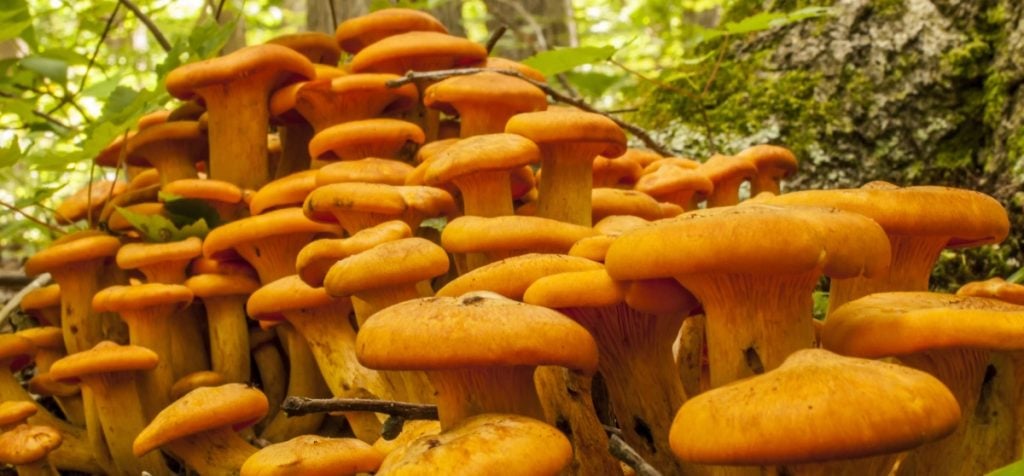
Identifying Pearl Oyster Mushrooms
Pearl oyster mushrooms are quite easy to identify. They have oyster or fan-shaped caps.
They also don’t usually have individual stems in the way that many other varieties of fungi do. Instead, oyster mushrooms grow together in clusters.
Oyster mushrooms also have decurrent gills, which means they run all the way down the cap and stem continuously.
All oyster mushrooms are saprotrophic. That means they live on dead or dying material. In the wild, you’ll most commonly find them growing on logs or dying trees.
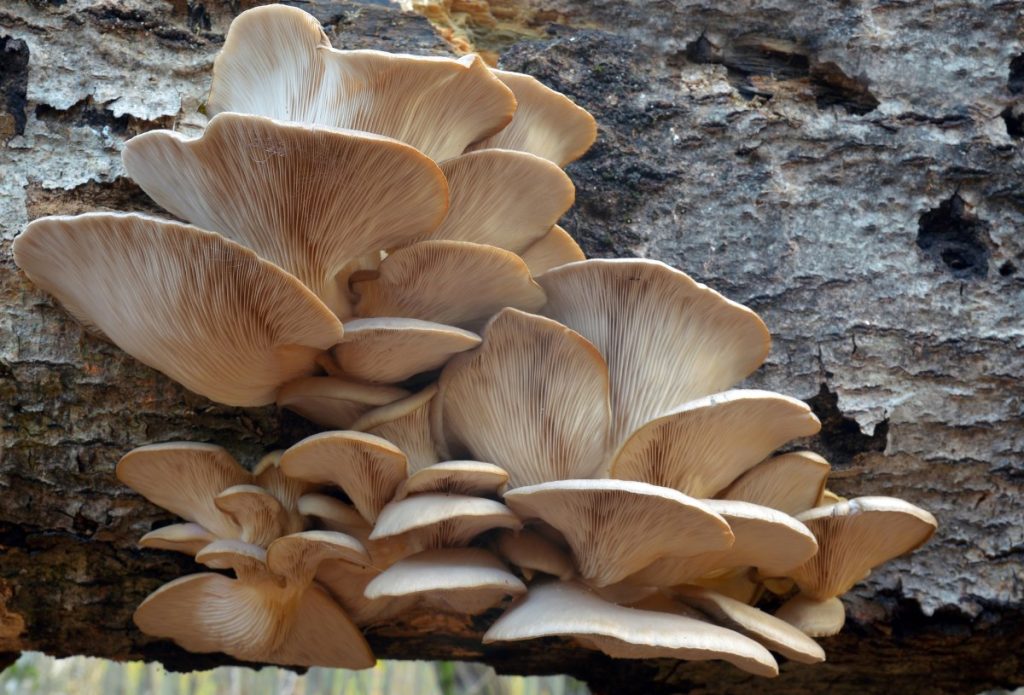
Are Oyster Mushrooms Good for Health?
Yes, oyster mushrooms (including pearl oysters) are a healthy food. Plus they just taste great!
Oyster mushrooms contain a high amount of protein. That makes them a great meat alternative.
They contain several different B vitamins, vitamin D and all of the essential amino acids. They’re also high in fiber.
Eating oyster mushrooms on a regular basis may help to lower high cholesterol. They’ll also lower risk factors for cardiovascular disease.
Oyster mushrooms have not been conclusively proven to help treat cancer.
However, some initial studies seem to indicate that oyster mushrooms can help slow or stop the spread of specific types of cancers. These include breast and colon cancer.
Oyster mushrooms have also been shown to reduce the size of tumors in studies on mice and rats.
You can get the benefits of oyster mushrooms by incorporating them into your diet. They’re also available dried in capsule form, or as medicinal mushroom extracts.
Learn more from our article called Health Benefits of Oyster Mushrooms.
How To Grow Pearl Oyster Mushrooms (Step by Step)
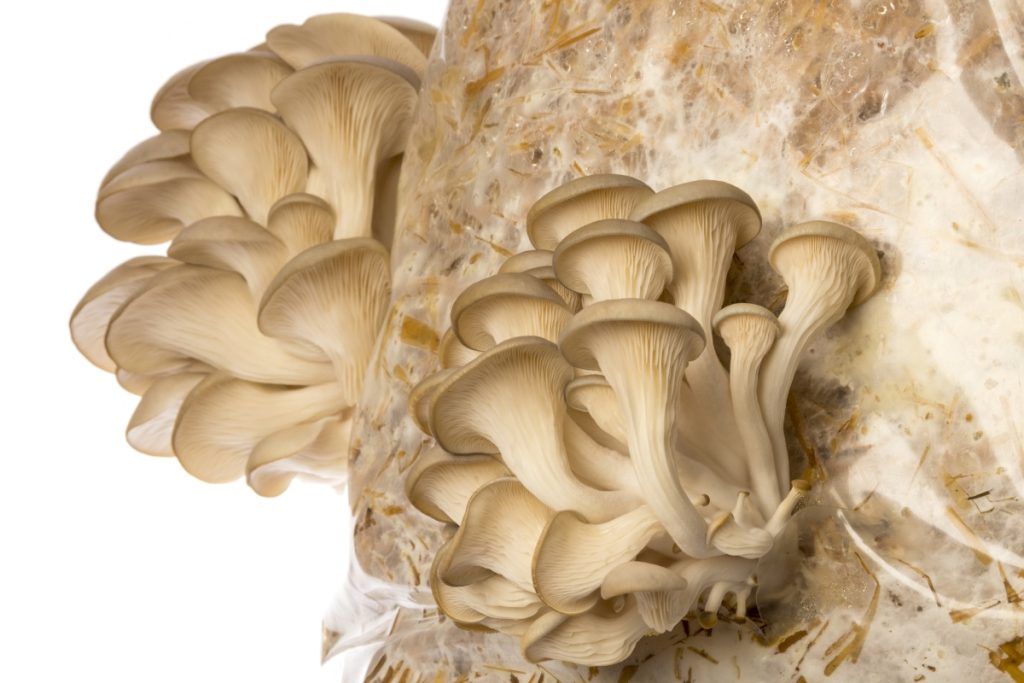
Growing pearl oysters is like growing any other common oyster mushroom strain.
For the most part, you can follow along with our step-by-step guide available here:
How To Grow Oyster Mushrooms: The Ultimate Step By Step Guide
There are a few key differences to keep in mind that make pearl oysters a bit different from other varieties though.
The first is that the incubation time for pearl oysters is a little longer than for summer oyster varieties like phoenix oysters. Pearl oysters take around 18 to 21 days to incubate, as opposed to 10 to 14 days.
The other thing to keep in mind is that pearl oysters are a cold weather variety. They prefer to grow in the temperature range of 12 to 18 C (53 to 64 F).
If grown in the correct temperature range, you’ll get large pearl oyster mushrooms with thicker and darker caps.
When pearl oyster mushrooms are grown above 18 C, the mushrooms become smaller. The cap will also be a lighter gray color.
To get the most possible out of mushroom growing, consider buying one of our online Mushroom Growing Courses.
They provide step by step video lessons showing every part of the process, from setup to harvest.
They’re suitable for beginners and teach you to grow mushrooms year round with minimal equipment.
Pearl Oyster Mushroom Recipes
Pearl oyster mushrooms can be used in any recipe that calls for oyster mushrooms.
They can also be used as a substitute in most recipes that call for button mushrooms. So don’t be afraid to experiment!
To get you started, check out our 5 Easy and Delicious Oyster Mushroom Recipes.
We recommend trying number 4 on the list, mushroom stir fry. Since pearl oyster mushrooms have a thicker and meatier cap, they hold up nicely even when cooked at higher temperatures.
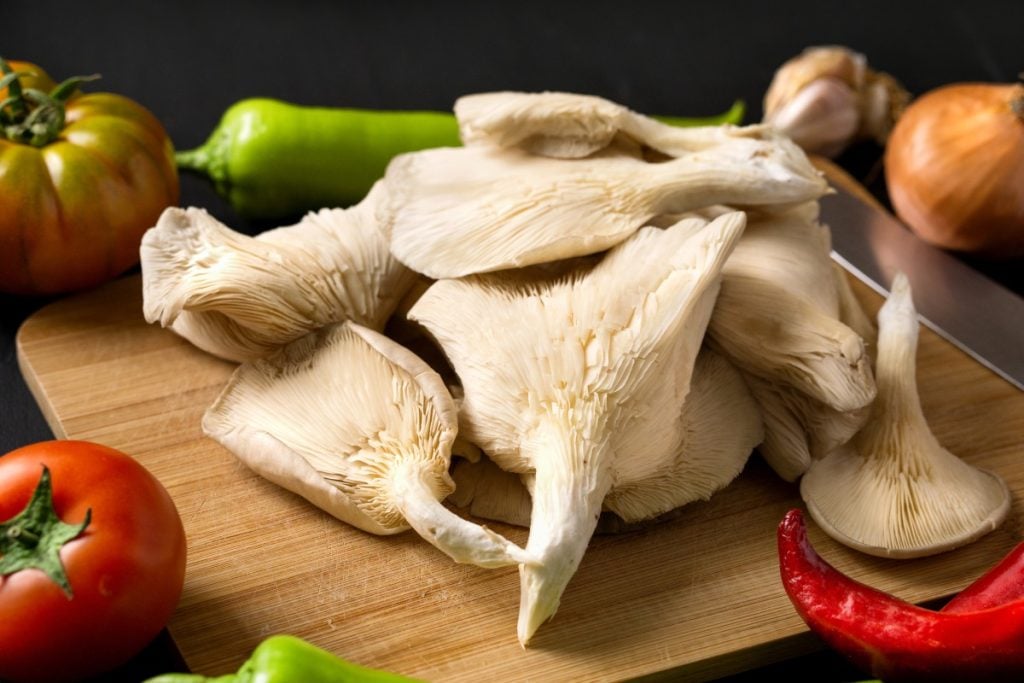
Final Thoughts
The pearl oyster mushroom is the most popular and widely-grown of any oyster mushroom strain.
They pack a rich, meaty flavor that works well in any recipe that calls for mushrooms.
Oyster mushrooms are packed full of vitamins and offer many health benefits too.
You can find oyster mushrooms growing in the wild. But pearl oysters are so easy to grow, that we think it’s less work to cultivate them yourself instead of going hunting for them.
If you’re interested in growing some delicious oyster mushrooms of your own, our Mushroom Growing Kit is a great way to get started. No previous experience required.
